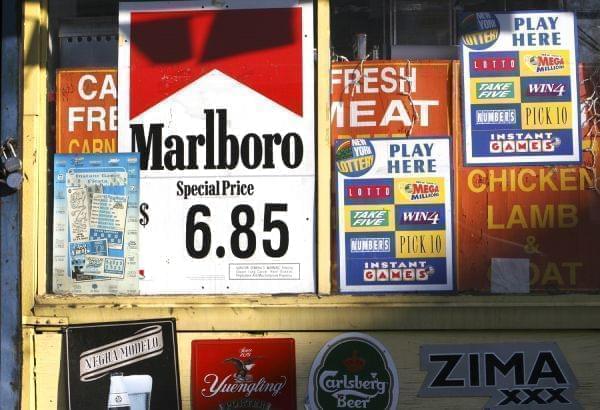Inside The Supreme Court’s $10-Billion Arguments

A New York convenience store displays window advertisements, including one for Marlboro cigarettes, Sunday, Dec. 11, 2005. That year, The Illinois Supreme Court threw out a $10 billion class-action lawsuit against Altria Group Inc.'s Philip Morris USA. (AP Photo/Mark Lennihan)
On Tuesday, the Illinois Supreme Court once again heard arguments over the largest judgment in the state's history. For the second time, Philip Morris is fighting a $10-billion dollar award to people who say they were tricked into thinking "light" cigarettes were healthy.
The class-action lawsuit has been before various courts in Illinois for a decade and a half.
David Frederick, a lawyer for the smokers, told the Supreme Court that regular and light cigarettes were made with the same amount of tobacco. It's just that light cigarettes had stronger filters — which smokers found a way to get around.
"Every smoker would compensate by drawing deeper to achieve the level of titration — which is the chemical level in the body for getting the nicotine that was desired," he said.
We'll come back to Frederick. But first we need to pause for some background. Back in 2003, a trial judge awarded the smokers $10.1 billion.
Philip Morris appealed directly to the Supreme Court, which in 2005, just barely ruled in the company's favor. The plurality opinion held that the Federal Trade Commission had implicitly authorized Philip Morris' "light" marketing.
That would have been that, except in 2008, the FTC indicated that no, actually it did not authorize the "light" marketing.
Lawyers for the smokers quickly moved to resuscitate their case. After years of more legal wrangling, they finally got an appellate court to do just that — which brings us to why Philip Morris is once again asking the Supreme Court for relief.
Former Illinois Gov. Jim Thompson, as he'd done more than a decade ago, argued on behalf of the cigarette maker. He said the smokers' attempt at a do-over came too late. Then he asked the justices.
"Where does this all end?," said Thompson. "Let's assume we lose."
OK. Under Thompson's hypothetical, Philip Morris pays $10 billion. But maybe someday the FTC gets new commissioners, and they say, no, the Illinois Supreme Court got it right the first time.
"Do we then get to file a motion for newly discovered evidence?," he said. "And do we get to trumpet the latest FTC opinion as that evidence? And do we get our money back?"
Now let's return to Frederick, the lawyer for the smokers. He didn't get far into his argument before Chief Justice Rita Garman interrupted with a question. She wrote the main Philip Morris opinion a decade ago, and wondered how it was that she could be overruled by an appellate court.
"What authority is there — whether it's constitutional or statutory or common law — that would allow a lower court to set aside a judgment of a higher court," she said.
Fredrick said while lower courts cannot overrule legal opinions, they can correct for errors in judgment under a section of the law known as 2-1401.
"2-1401 is designed to achieve justice, and it has been applied that way in every one of this court's cases, regardless of the point at which the erroneous decision in the judicial process occurred — whether that was at the circuit court level or the appellate court level," he said.
Fredrick acknowledged this is the first time where it had been used on the Supreme Court, but he argued that shouldn't matter.
A decade ago, Philip Morris escaped having to pay that large damage award by the bare minimum plurality of four justices.
It's worth noting that two of those four are no longer on the court. And with a recusal leaving only six justices to make a ruling, it raises the possibility that the court might not reach the four votes needed to issue a decision. That could leave the appellate court ruling — and the $10-billion judgment — to stand.

